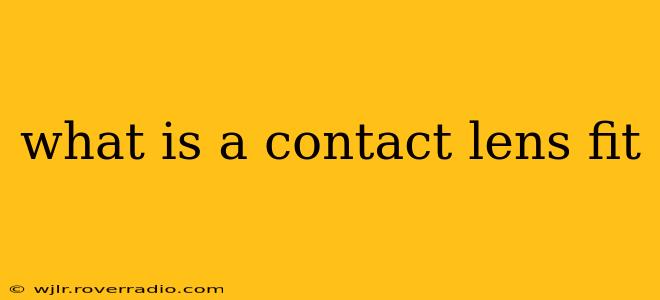A contact lens fit is more than just finding a lens that fits your eye; it's a precise process ensuring comfort, vision correction, and overall eye health. It's a personalized experience tailored to your unique needs and eye characteristics. This detailed guide will explore the intricacies of a contact lens fit, answering common questions and providing valuable insights.
What Happens During a Contact Lens Fitting?
A contact lens fitting typically involves several key steps:
-
Comprehensive Eye Exam: This is crucial. Your eye care professional will assess your refractive error (nearsightedness, farsightedness, astigmatism), measure your corneal curvature (the shape of your eye's surface), evaluate your tear film (the lubricating layer on your eye), and check for any eye diseases or conditions.
-
Lens Selection: Based on the exam results, your optometrist or ophthalmologist will recommend suitable lens types, materials, and parameters (like diameter, base curve, and power). Several factors influence this decision, including your prescription, lifestyle, and personal preferences. They might start with trial lenses to determine the best fit.
-
Trial Lens Application and Evaluation: You'll have the opportunity to wear trial lenses for a period of time, allowing your eye care professional to observe how they fit and perform. They'll assess comfort, clarity of vision, and the overall health of your eyes. This may involve multiple visits to ensure the optimal lens is selected.
-
Follow-Up Appointments: After the initial fitting, follow-up appointments are essential. Your eye care professional will monitor your eyes for any adverse reactions, adjust the lens parameters if needed, and ensure the lenses maintain proper fit and function over time. This is particularly important in the initial stages to prevent complications.
What Types of Contact Lenses are Available?
Various contact lenses cater to diverse needs and preferences. Common types include:
-
Soft Contact Lenses: Made from soft, flexible materials, they are generally comfortable and easy to wear. They come in daily, two-weekly, monthly, and extended-wear options.
-
Rigid Gas Permeable (RGP) Lenses: These lenses provide sharper vision, especially for individuals with astigmatism or irregular corneas. They are more durable than soft lenses but may take some time to adjust to.
-
Multifocal Contact Lenses: Designed to correct presbyopia (age-related loss of near vision), these lenses offer clear vision at various distances.
-
Toric Contact Lenses: These lenses are specifically designed to correct astigmatism, a condition affecting the shape of the cornea.
How Long Does a Contact Lens Fitting Take?
The duration of a contact lens fitting varies. The initial consultation and examination can take anywhere from 30 minutes to an hour, while subsequent follow-up appointments may be shorter. Multiple visits are often necessary to find the perfect fit.
What is the Cost of a Contact Lens Fit?
The cost of a contact lens fitting depends on several factors, including the type of lenses, the number of follow-up visits, and the fees charged by your eye care professional. It's best to discuss the cost with your optometrist or ophthalmologist upfront.
What Should I Expect During My Contact Lens Fitting?
Expect a thorough eye examination, a discussion of your lifestyle and preferences, the opportunity to try different lenses, and follow-up appointments to ensure proper fit and comfort. Don't hesitate to ask questions and voice any concerns. Open communication is key to a successful contact lens experience.
How Often Should I Get My Contact Lenses Checked?
Regular check-ups are crucial for maintaining eye health and ensuring the proper fit of your contact lenses. The frequency of these appointments will depend on the type of lenses you wear and your individual needs, but generally, at least once a year is recommended, and more frequently for specific lens types.
By understanding the contact lens fitting process, you can actively participate in ensuring optimal vision correction and eye health. Remember, choosing the right contact lenses is a collaborative effort between you and your eye care professional.
